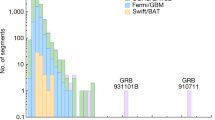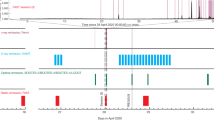Abstract
Early studies of the time histories of the γ-ray burst events reported by the Vela satellites led to the suggestion that very brief, ∼ 0.1 s, bursts formed a class distinct from the longer, highly structured bursts1. Results of the KONUS experiments on Veneras 11, 12, 13 and 14 argue for the existence of a separate class of short-duration γ-ray bursts2, revealing that many of the short bursts exhibit much softer spectra ( ∼ 30 keV) than the more familiar complex bursts. Although this correlation is not completely clear and the observations are in some cases contradictory2–6, the existence of two γ-ray burst populations is suggested by Fig. 1, showing a duration histogram for 24 events detected by our ISEE-3 experiment. Figure 1 also shows the distribution of 123 Venera 13 and 14 events (60 detected by both spacecraft) and suggests two γ-ray burst populations in each experiment sample, the domains separated with a minimum near 1 or 2s. Here we point out that the results of the Goddard ISEE-3 γ-ray burst spectrometer actually enhance the appearance of two burst populations suggested in the Venera data.
This is a preview of subscription content, access via your institution
Access options
Subscribe to this journal
Receive 51 print issues and online access
$199.00 per year
only $3.90 per issue
Buy this article
- Purchase on Springer Link
- Instant access to full article PDF
Prices may be subject to local taxes which are calculated during checkout
Similar content being viewed by others
References
Cline, T. L. & Desai, U. D. Proc. 9th ESLAB Symp., 37–45 (ESRO, Noordwijk, 1974).
Mazets, E. P., Golenetskii, S. V., Guryan, Yu. A. & Ilyinskii, V. N. A. F. loffe Physico-Technical Inst. Rep. No. 738 (1981).
Mazets, E. P. & Golenetskii, S. V. A. F. loffe Physico-Technical Inst. Rep. No. 632 (1979).
Laros, J. G. et al. Astrophys. J. Lett. 245, L63–L66 (1981).
Laros, J. G., Evans, W. D., Fenimore, E. E. & Klebesadel, R. W. Astrophys. Space Sci 88, 243–246 (1982).
Barat, C. et al. Astrophys. J. Lett. (in the press).
Teegarden, B. J. et al. in Gamma-Ray Spectroscopy in Astrophysics (eds Cline, T. L. & Ramaty, R.) NASA TM79619, 516–528 (1978).
Teegarden, B. J. & Cline, T. L. Astrophys. J. Lett. 236, L67–L70 (1980).
Cline, T. L. Ann. N. Y. Acad. Sci. 375, 314–329 (1981).
Mazets, E. P. et al. Soviet Astr. Lett. 5, 87–90 (1979).
Mazets, E. P. et al. AIP Conf. Proc. 101, 36–53 (1983).
Diyachkov, A. V. et al. Adv. Space Res. 3, 211 (1980).
Barat, C. et al. Space Sci. Inst. 5, 229–235 (1981).
Author information
Authors and Affiliations
Rights and permissions
About this article
Cite this article
Norris, J., Cline, T., Desai, U. et al. Frequency of fast, narrow γ-ray bursts. Nature 308, 434–435 (1984). https://doi.org/10.1038/308434a0
Received:
Accepted:
Issue Date:
DOI: https://doi.org/10.1038/308434a0
This article is cited by
-
Multidimensional analysis of Fermi GBM gamma-ray bursts
Astrophysics and Space Science (2019)
-
Classifying GRB 170817A/GW170817 in a Fermi duration–hardness plane
Astrophysics and Space Science (2018)
-
The duration distribution of Swift Gamma-Ray Bursts
Astrophysics and Space Science (2016)
-
Gamma ray bursts of black hole universe
Astrophysics and Space Science (2015)
-
An exceptionally bright flare from SGR 1806–20 and the origins of short-duration γ-ray bursts
Nature (2005)
Comments
By submitting a comment you agree to abide by our Terms and Community Guidelines. If you find something abusive or that does not comply with our terms or guidelines please flag it as inappropriate.



